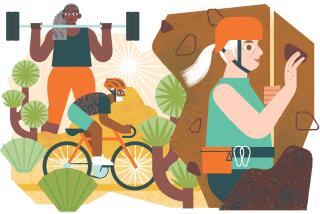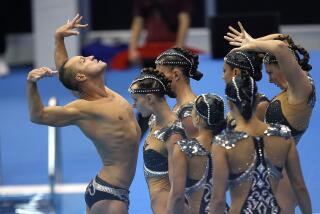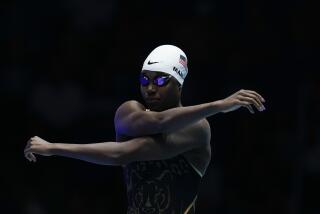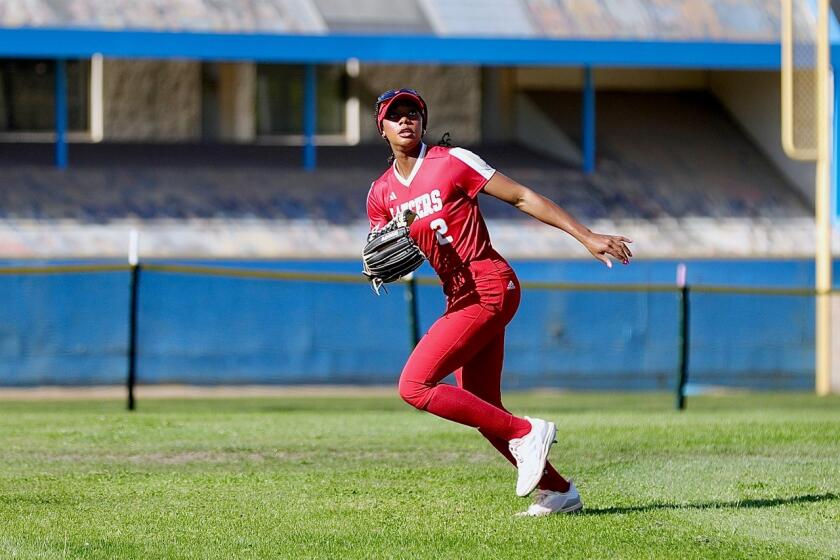Swimmer, 60, Leaves Youngsters in His Wake
- Share via
If you’re within 20 years of 60-year-old Don Hester, president of the Santa Monica Marina Masters swim club, don’t race him. Chances are, he’ll embarrass you.
Hester, who carries himself like a spirited young adult, recently set two national age-group records in the Short Course National Championships at Palo Alto, a 33:01 in the 50-meter breaststroke and a 1:16.02 in the 100 breast. His 2:52 in the 200 breast broke no record but was good enough for first place.
Record-setting performances in his age group are nothing unusual for Hester. What is unusual is that he consistently swims faster today than he did in high school.
How does he do it? Modern swimming techniques and improved training methods.
But it is more than the contemporary science of swimming. Hester’s desire to compete and, more than anything else, to stay healthy are major reasons for his success.
“I hope to keep swimming for as long as I can,” said Hester, who works out up to seven days a week at Santa Monica City College. “My father swam until he was 90, so I might as well be the 90-year-old doing it. I don’t know why I shouldn’t.”
Hester has toted around this kind of enthusiasm since 1980 when he started swimming again after a 30-year hiatus during which he completed his residency and internship and opened a successful practice as an orthopedic surgeon. He regrets not swimming during the prime of his life.
“I didn’t do any swimming with my residency and internship and starting a practice because there wasn’t any time,” Hester said during an interview in his Santa Monica office. “But I wish I had taken the time, because after I got out of training I could have stayed in shape while I was in practice.”
In 1980 Hester enrolled in a swimming conditioning course at Santa Monica City College and moved from there into the Masters program because it provided him an opportunity to compete.
Masters swimmers aged 25-90-plus compete in meets sanctioned by U. S. Masters Swimming that are held around the country. The USMS was founded in 1970 and boasts 30,000 members. Hester is a member of the Southern Pacific chapter and competes in the 60-64 age bracket.
“The program goes from 25 up to Methuselah if you want it,” he said. “If you live long enough you are a guaranteed winner.”
Masters swimming keeps no time standards, allowing anybody to participate. Both the recreational and competitive swimmer become Masters swimmers. According to Clay Evans, Hester’s coach and a co-founder of the Marina Masters Club, 70% of Masters participants have never swum competitively.
But Hester enjoys the competition. “I don’t think that competition per se is good. I think it’s good for those who like a competitive challenge,” he said, “and for me it’s a good way of staying in shape. It’s kind of a way of assessing yourself.”
Hester says most Masters competition is friendly. “The spirit of Masters swimming is that everybody’s helping each other out, improving themselves, and nobody seems to be worried about the competition as a threat.
“It’s not as though it’s important to be in better shape than anybody else.”
Still, competition has benefits, particularly for a competitive person like Hester. It gives him an incentive to keep in top form.
“Don is so good,” said Evans, a medal winner on the 1976 Canadian Olympic Team. “He wants to win but he also wants to stay in shape, and one goes hand in hand with the other.”
While keeping participants healthy, the Masters program also reunites people who competed in the pool many years earlier. Rube Wolf, who swam with Hester at Beverly Hills High School before competing for USC, made contact again with his high school buddy after joining the Trojan Masters Club 12 years ago. The two 60-year-olds had not been on the same team since high school until the recent Short Course nationals.
There, the Marina Masters and Trojan Masters put together a team called the South Coast Aquatic Masters, “otherwise known as SCAM, and it was a scam to get us more points,” Wolf said with a chuckle, despite finishing second to a Bay Area team.
The great thing about the Masters program, said Wolf, is that “you renew acquaintances and see people you knew 20 or 30 years ago. I remember I had the dubious distinction of hitting Don in the face when we were playing water polo a long time ago, and now we’re kind of in a swimming fraternity.”
Added Hester: “Sometimes at these Masters meets you meet your old college buddies. The same ones you raced against then you’re racing against now, albeit a little grayer and a little slower.”
Hester enjoys watching Masters participants older than him breathe new life into their time-worn bodies.
“Sometimes it’s incredible to see a little old lady at 90 get in the water, not just swim, but get in and swim the butterfly for 200 yards,” he said.
“She can barely keep her head above water and she goes ‘thrash, thrash’ with her kick, which doesn’t do much, and then pushes all this water ahead of her with her arms so she goes backward and then she goes forward, and it takes her forever to swim it but she does the whole damn thing.”
A 90-year-old doing the butterfly?
“Swimming is something you can do at any age,” said Hester, whose children also are water sports enthusiasts. “When you get older and your joints get arthritic, you can’t pound them the way you used to. It’s been my observation that everyday you get older the ground gets a little harder.”
The water, though, stays pillow-soft and its therapeutic value is considered unparalleled. The buoyancy of the body gives even the most out-of-shape swimmer a chance to exercise most muscle groups and perhaps the most important muscle, the heart. Running, aerobics and team sports improve cardiovascular fitness, but each sport often exposes participants to serious injuries. Swimming is virtually risk-free, Hester said.
“Swimming is as close to an ideal exercise as you can get,” he said. “You can achieve aerobic condition to almost as high a degree as the most extensive running. And at the same time you don’t suffer trauma to the joints.
“Swimming puts enough demand on you or you can make it put enough demand on you so you have cardiovascular stress, which means then that you get a stronger heartbeat, greater endurance and more cardiovascular reserve. If you get hurt in an auto accident or even suffer a heart attack, it’s then when you need your reserve.”
Hester believes swimming yields psychological benefits also. His wife Mary, a part-time nurse at Santa Monica Hospital, agrees. She has to cope with Hester when he returns from a long, stress-filled day at work, and she said Hester’s swimming makes him easier to live with.
“The part that is so wonderful,” she said, “is that in his business there is so much tension and swimming is so great at relieving that. It diverts his attention.”
“Swimming is cathartic,” said Wolf, who taught water survival in the service in World War II. “It’s a complete flush. My wife says I’m a nicer person when I come back from swimming.”
Wolf said if everybody exercised the way he does, the world would be a better place. It’s Wolf’s and Hester’s determination to stay healthy that generates such simple idealism. Each has broken several Masters records in recent years, and both claim swimming makes them younger.
The hard part is convincing others to participate. “My father is constantly encouraging me to get back into swimming,” said Jim Hester, 33, Don’s oldest son. “I’m always interested in doing it, but it’s just a matter of time.”
“He talks about it to a lot of friends,” Mary Hester said. “People can’t run and he says swimming is a lot easier.”
Hester believes many older people can achieve what he has, especially when it comes to looking and feeling younger.
If they need a springboard to get started, said Hester, they can pick up the annual Masters swimming calendar. Photos of the best-looking male and female Masters swimmers fill the pages, with youngest participants appearing next to the early months of the year and the oldest appearing near the end.
“January looks pretty good,” Hester said. “By December they’re getting kind of old, but they certainly still look all right.”
More to Read
Get our high school sports newsletter
Prep Rally is devoted to the SoCal high school sports experience, bringing you scores, stories and a behind-the-scenes look at what makes prep sports so popular.
You may occasionally receive promotional content from the Los Angeles Times.






